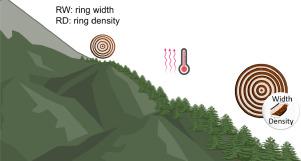Agricultural and Forest Meteorology ( IF 5.6 ) Pub Date : 2022-08-18 , DOI: 10.1016/j.agrformet.2022.109109 L. Carrillo-Arizmendi , M. Pérez-Suárez , J.J. Vargas-Hernández , P. Rozenberg , A.R. Martínez-Campos

|
In alpine forests, the impact of warming differs at the upper and lower extremes of the elevation gradient causing trees to compensate through different adaptive mechanisms. The objective was to retrospectively evaluate the radial growth response to recent interannual climate variation in Pinus hartwegii trees growing at the extremes of their elevational gradient on two volcanic mountains in central Mexico (La Malinche and Nevado de Toluca). Increment cores collected from 174 P. hartwegii trees were used to estimate time-series of growth ring including ring width and density variables, as well as basal area increment (BAI) and ring biomass (BIO) for 1964–2016. Differences in average radial growth and time-trends of ring variables in response to climate variables were estimated based on correlations of ring variables, BAI, and BIO with inter-annual variation in temperature, rainfall, and length of the frost-free period (FFP). Results showed higher average values of ring width and density variables, as well as BAI and BIO (i.e., higher productivity) at low elevation on both mountains. Time-trends for BAI and BIO were positive at both ends of the elevation gradient, but ring width and density variables followed opposite trends. Inter-annual variation of ring variables was explained more by temperature than by rainfall or FFP; however, temperature was negatively correlated with RW and positively with RD, even though BAI and BIO were positively correlated with temperature (All them with P < 0.001) at both elevational end on both mountains. For most of the ring variables, the total variation explained by the ANOVA model was more related to the linear warming trend (greater than 67%). Warming is affecting radial growth of P. hartwegii trees differently at high versus low elevation on both mountains, showing warning signs from the perspective of functional traits, but not in terms of productivity.
中文翻译:

变暖对 P. hartwegii Lindl 年轮变量的影响。位于墨西哥中部自然海拔分布的极端
在高山森林中,变暖的影响在海拔梯度的上限和下限不同,导致树木通过不同的适应机制进行补偿。目的是回顾性评估在墨西哥中部的两座火山(La Malinche 和 Nevado de Toluca)上生长在极端海拔梯度上的哈特威吉松树对最近年际气候变化的径向生长响应。从 174 P. hartwegii收集的增量核心树木被用来估计年轮的时间序列,包括年轮宽度和密度变量,以及 1964-2016 年的基面积增量 (BAI) 和年轮生物量 (BIO)。根据年轮变量、BAI 和 BIO 与温度、降雨量和无霜期长度(FFP )。结果显示,在两座山的低海拔地区,环宽和密度变量的平均值以及 BAI 和 BIO(即更高的生产力)的平均值更高。BAI和BIO的时间趋势在海拔梯度的两端都是正的,但环宽和密度变量的趋势相反。环变量的年际变化更多地由温度而不是降雨或FFP来解释;然而,P < 0.001)在两座山的两个海拔端。对于大多数环变量,ANOVA 模型解释的总变化与线性变暖趋势更相关(大于 67%)。变暖对两座山上高海拔和低海拔地区P. hartwegii树的径向生长的影响不同,从功能性状的角度显示了警告信号,但在生产力方面却没有。







































 京公网安备 11010802027423号
京公网安备 11010802027423号